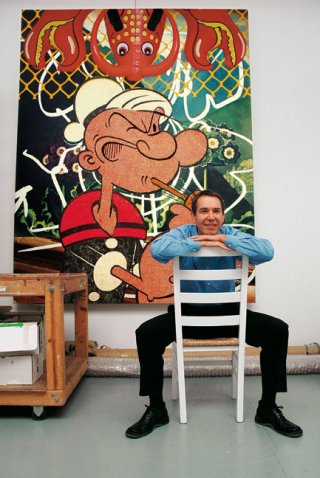
Yesterday I flew to Auckland to farewell a dear friend. I think funerals are private affairs, so I'll just confine myself to saying that the commemoration was as warm, as funny, as packed with people, as surprising and yet as straightforward as befitted the intensely well-lived life being celebrated.
In moments of heightened emotion, or at times of some kind of historical import, I often find myself looking around for some kind of object or image to fix on, something that will provide an anchor point in my memory for the events of the day. Writing it in my head, I suppose, before it's even done. Significant moments always seem surrounded and heralded by signs in the physical world: equivalences, perhaps. Blame it on all the art history (I certainly do); especially those several years I spent grudgingly studying medieval iconography, whose method I still can't seem to shake off, try as I might. Often the details I look for seem like a kind of lodestone, a visual symbol from the everyday world which has the story folded up inside itself like an old map waiting to be smoothed out.
At the church yesterday I looked for that image which might contain the day, but I didn't find it in the single candlestick, nor in the stained glass windows, nor even the slides which were screened later in the church hall. I'm not sure, really, what I was looking for. A drum kit? A bull's-eye? A circle in a square on a piece of paper blowing along the road? When the service was over everyone walked out of the church and stood in the churchyard and lined the pavement. There was a heaviness, and a profound sadness, and hardly anyone was talking. Then it started to rain, and I took my scarf out of my handbag and put it over my head. When the car drew away from the church and turned down the road, the rain stopped and I put my scarf away. I thought then of the various tangi I've been to where the rain's fallen, though none's been forecast -- roimata, they call it, or tears of heaven -- and I wasn't surprised that it rained today.
Funerals offer a chance to reflect, not only on the person who has gone but on one's own life. It's a marking point, a time to take stock. I realised, sitting there, surrounded by art people, that this -- writing about art, thinking about the artworld, considering the ways art provides analogies for everyday life -- is what I've been doing for twenty years now and it's unlikely that I'll ever do anything else. It was a strange moment, but I felt comfortable. It's a worthwhile project that we're all engaged on, and that's enough.
When I got home I felt exhausted, wrung out by the travel and the sadness. I had a glass of wine and told the big guy about the day and sat down in front of the computer. I read my emails, and idly looked at the site stats for Art, Life, TV, Etc. And suddenly I saw it. The thing to remember, the thing that might tell the story. It had been here all the time: the hundreds of hits from all over the world which had come from people googling 'Julian Dashper' over the past few days.
When I wrote down a list of some of the places where he has come to mind, suddenly the world seemed a very small place. The hits reveal a community of strangers with Julian Dashper in common, people whose internet searches appear like tiny points of light being illuminated all over the globe. If any other proof were needed of the significance of the artist and the work, I think this list reveals it.
Auckland, New Zealand
London, England
Wichita, Kansas, USA
Omaha, Nebraska, USA
Berlin, Germany
Brooklyn, New York, USA
Chicago, Illinois, USA
Eugene, Oregon, USA
Mission, Kansas, USA
San Francisco, California, USA
Boston, Massachusetts, USA
Seoul, Korea
Palmerston North, New Zealand
Dipton, Southland, New Zealand
San Diego, California, USA
Takaka, Nelson, New Zealand
Austin, Texas, USA
Redhill, Surrey, England
Seattle, Washington
New Orleans, Louisiana, USA
Christchurch, New Zealand
Toowoomba, Queensland, Australia
Lower Hutt, Wellington, New Zealand
Windsor, New South Wales, Australia
Southampton, New York, USA
Chatswood, New South Wales, Australia
Maspeth, New York, USA
Wellington, New Zealand
Jamaica, New York, USA
Versailles, Ile-de-france, France
Toronto, Canada
Sydney, Australia
Hong Kong
Syracuse, New York, USA
Buena Park, California, USA
North Shore, Auckland, New Zealand
Albuquerque, New Mexico, USA
Santiago de Compostela, Spain
Roswell, New Mexico, USA
Dunedin, New Zealand
Weston, Missouri, USA
Hilversum, the Netherlands
Lincoln, Nebraska, USA
Invercargill, New Zealand
Jeffersonville, Indiana, USA
Verl, Nordrhein-Westfalen, Germany
Camberwell, Victoria, Australia
Richmond, Virginia, USA
Dhaka, Bangladesh
Houston, Texas, USA
Gisborne, New Zealand
Attiki, Athens, Greece
Hamilton, New Zealand
Nelson, New Zealand
West Burleigh, Queensland, Australia
Tuakau, New Zealand
Montreal, Canada
Salina, Kansas, USA
Durham, North Carolina, USA
Columbia, Pennyslavania, USA
 Louise Bourgeois, Sleep II, 1967, marble on two wooden timbers, Tate Modern
Louise Bourgeois, Sleep II, 1967, marble on two wooden timbers, Tate Modern

















